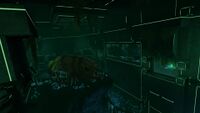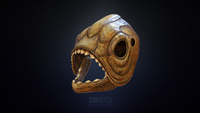Research Specimen: Difference between revisions
GemmaBeepo (talk | contribs) No edit summary |
GemmaBeepo (talk | contribs) (→Shell) |
||
| Line 26: | Line 26: | ||
==Shell== |
==Shell== |
||
A solid external sell as well as an internal skeleton is commonplace amongst this group, with the Sand Shark, Boneshark, Theta and presumably the Rockgrub all exhibiting this adaptation showing a preference for defensive capability over manoeuvrability in all species aside from the Biter and Blighter, which appear to have lost the external shell over time in favour of higher speed. |
A solid external sell as well as an internal skeleton is commonplace amongst this group, with the Sand Shark, Boneshark, Theta and presumably the Rockgrub all exhibiting this adaptation, showing a preference for defensive capability over manoeuvrability in all species aside from the Biter and Blighter, which appear to have lost the external shell over time in favour of higher speed. |
||
{{clear}} |
{{clear}} |
||
==Data Bank Entry== |
==Data Bank Entry== |
||
{| style="width: 100%;" class="article-table sortable" border="0" cellpadding="1" cellspacing="1" |
{| style="width: 100%;" class="article-table sortable" border="0" cellpadding="1" cellspacing="1" |
||
Revision as of 23:19, 31 March 2018

|
Read at own risk This article contains unmarked spoilers. Players new to the game would want to avoid or be cautious toward this article. |
<infobox layout="stacked">
<title source="title" style="font-weight:bold; text-align:center;"> <default>Research Specimen</default> </title> <image source="image">
</image> <label>Age</label> <label>Status</label> <label>Biome</label> <label>Length</label> <label>Coordinates</label> <label>GoTo</label> <label>Debug Spawn</label> </infobox> This large predator was kept in the main aquarium of the Disease Research Facility for a long period of time for testing purposes. The skeleton is very odd in appearance, having a solid exterior shell, as well as an interior skeleton. It is assumed that this species died off around 1000 years ago due to Kharaa. This specimen is distantly related to five species still living on the planet today; the PDA notes shared skeletal traits with the Biter and Sand Shark, by extension this also makes Research Specimen Theta a relative of the Boneshark and Blighter, and a very distant relative of the Rockgrub.
Forearms
The forearms are unique amongst its relatives and seem to have evolved independently, as there is very little chance of relation to the Sea Emperor and Sea Dragon order and the skeletal structure of the arms differs greatly between them; whilst the Sea Dragon's - and presumably the Sea Emperor's - arms follow a more familiar structure with a ball and socket joint at the elbow, one upper bone; the humerus and two lower bones; the radius and ulna, Theta's arms are unique, with the humerus's equivalent made from two fused bones of equal size running parallel to each other, and rather than the ball and socket joint seen in the elbow of the Sea Dragon, it has a gliding joint composed of carpal bones.
Eyes
The secondary eyes appear considerably smaller and less developed that those found on the Sand Shark and Biter, in which they are indistinguishable from the front set of eyes in size and appearance. It can also be noted that the Boneshark lacks double eye sockets as well as any indication of their prior existence, meaning that the Boneshark must have diverged sooner than the others.
Shell
A solid external sell as well as an internal skeleton is commonplace amongst this group, with the Sand Shark, Boneshark, Theta and presumably the Rockgrub all exhibiting this adaptation, showing a preference for defensive capability over manoeuvrability in all species aside from the Biter and Blighter, which appear to have lost the external shell over time in favour of higher speed.
Data Bank Entry
|
The skeletal remains of a vast predator, housed within an artificial habitat.
|




